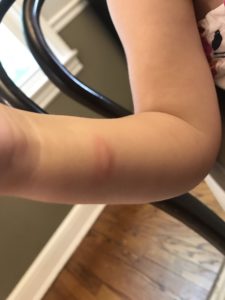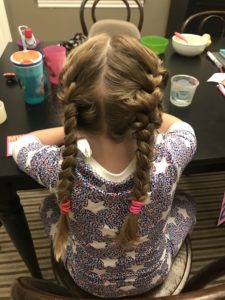White House Nannies
As a pediatrician, I get asked lots of questions about having children that don’t fall into the “medical advice” category. Everything from advice about different pre-schools to my favorite place to host a birthday party. One area that comes up frequently is nannies – how to find them, what to ask them, how to keep them. Sadly these topics are not covered in medical school though some may argue they should be!
I do offer some child care tips to my families searching for the perfect person to care for their little ones. Getting recommendations and following up on references is key. So is making sure your nanny is CPR certified and up to date on vaccines (this includes being on board with getting the yearly flu shot). It’s also a good idea to discuss sick day policies ahead of time and coming up with an agreed-upon plan for when the nanny is sick or your child is. Being on the same page regarding feeding, boundaries, and sleeping is also important. If you plan to have your child cry it out for naps but your nanny intends to rock her to sleep, you are going to have some disagreements. Beyond that most of my nanny recommendations come from my experience as a mom and the lucky employer of the best nanny ever.
That’s why Spring Valley Pediatrics is bringing in professionals to answer the myriad other childcare questions we know you have. On Thursday, January 23rd at 7pm, Barbara Kline, the owner of White House Nannies, will be at our office answering all of your nanny questions. Come ready to raise your hand – we look forward to hosting you!

Mosquito Bite Treatment
We all know D.C. is a mosquito haven but thankfully Dr. Jessica Long from Spring Valley Pediatrics has some tips to keep your children comfortable and itch-free!

It’s August in D.C. which means my children are scratching like crazy at a myriad of bug bites all over their sweet little bodies. It doesn’t matter how aggressively I spray, pat, or wipe them down with bug repellant, those pesky mosquitos find them (my middle child is apparently especially delicious) and I get to hear the gripes all day long. They itch and it is not fun. What’s a parent to do?
You probably already have the prevention piece down (and if not, read my past post) but no matter how diligent you are, one or two little bugs are going to find their way through the haze of DEET. Mosquito bites tend to be pink, slightly raised, itchy, and can have some swelling especially if they are on the face or ankle (tick or spider bites have different characteristics and may require different treatment). Kids’ skin tends to react more than adults’ skin, so their mosquito bites will often look bigger than your own.
It’s easier said than done, but try to encourage your child not to scratch the bite. It will only irritate the area, making it even itchier, and can also lead to infection. Placing an ice pack or a cool washcloth on the area can help reduce the itch, as can a steroid cream (such as 1% hydrocortisone cream) which can be applied two to three times a day. Other topical treatments like calamine lotion can be incredibly soothing as well.
Sometimes all the creams in the world just don’t take the edge off and your kid is still miserable, especially at bedtime. Benadryl for fast relief or a longer acting allergy medication might be a good choice, but be sure to discuss the medication and the proper dose with your pediatrician. A mosquito bite itches for about 3-4 days so you’ll want to keep up treatment for at least that length of time.
Hopefully these tips will help you and your kids enjoy the outdoors all summer long!
Head Lice

Back to school comes with lots of fun things – a new backpack and lunch box, seeing old friends and making new ones, the start of Fall. Unfortunately, it also causes an increase in the amount of lice we see in our office. While harmless, these bugs are irritating for the whole family and can lead to absences from school and work. This school year, be armed with the knowledge of how to prevent and, if needed, treat these pesky uninvited guests.
What are lice?
Lice are tiny gray bugs that can infest the scalp. They are about the size of a sesame seed and move quickly so can be difficult to see. What you often do find are their white eggs, called nits, which firmly attached to hair shafts near the skin. Unlike dandruff or sand, nits cannot easily be shaken off the hair shaft. Most people who get lice complain of an itchy scalp. Lice do not carry diseases and will not make you feel sick.
Lice life cycle
Nits hatch into lice in about one week. They can survive off the scalp during that time which makes cleaning your house imperative when treating a lice infection in the family. Adult lice can live three weeks on the scalp and feed every few hours on tiny amounts of blood from the scalp. Off the scalp, adult lice cannot survive for more than one day without a blood meal.
Transmission
Nits cannot pass from person to person; only live lice can infect other people. Almost all transmission is from direct head-to-head contact. Since lice cannot jump or fly, it takes about 30 minutes of direct contact for a louse to crawl from one head to another. However, indirect transmission from hats, hairbrushes, headphones and other objects is possible though less common. Most transmission of lice happens at home, through sleepovers and bed sharing.
 Treatment
Treatment
Anti-lice shampoo (such as Nix which is over the counter) is the mainstay of treatment and requires two treatments so be sure to follow the package directions. Prescription anti-lice medication such as Sklice, is also available and requires only one application. Discuss with your doctor if this is a good choice for your family.
When using the anti-lice shampoo, first wash hair with a regular shampoo and towel dry. Do not use conditioner on the hair as it interferes with the lice treatment. Pour 2 ounces (one box of Nix if that’s what you are using) into damp hair. People with long hair may need to use two boxes. Work the cream into all the hair down to the roots and add a little warm water if needed to work up a lather. Leave the shampoo on for a full 10 minutes and then rinse the hair thoroughly with water and towel dry. Again, do not use conditioner. Do not shampoo the hair for 48 hours after application of anti-lice shampoo and avoid hair conditioner before treatment as well as for 2 weeks after.
Most importantly, most over the counter shampoos require that you repeat the entire process 9 days later to kill any nits that survived. Since nits hatch 6-9 days after being laid, the second treatment will ensure that lice that hatch from surviving nits are also killed.
Preventing Spread
Now that the hair is under control, it’s time to address the house. Vacuum your child’s room thoroughly as well as the rest of the house. Soak hairbrushes for 1 hour in a solution containing anti-lice shampoo. Wash bed sheets, blankets, pillowcases and any clothes worn in the past three days in hot water; water temperature of 130 degrees Fahrenheit kills lice and nits. For items that cannot be easily washed, such as hats or stuffed animals, place them in sealed plastic bags for 2 weeks to ensure that all nits and lice are dead. Remind family members not to share combs or hairbrushes to prevent passing lice in the future.
Most importantly
Don’t stress! Lice infection does not happen because of a lack of cleanliness – it just happens. If you follow the above steps, lice and their nits should be successfully killed. Children can return to school and daycare after treatment with an anti-lice shampoo. A child does not need to miss any school or childcare due to nits remaining after treatment since nits are not contagious. Always contact your doctor if you are unsure if your family has lice, are unable to successfully treat them with the above steps, or have additional questions.
Wishing you a happy and lice free school year!
Helping with Immunizations

I always hoped that, since I’m a pediatrician, my children would have no qualms about anything that happens at the doctor’s office. I was wrong. My children get as upset about shots, as fearful of a blood draw, and as manic about opening their mouths for a strep swab as the next kid. But shots don’t have to be a horrible experience for kids and parents alike. There are simple things we can do to calm our child, no matter her age, to make everything go a bit smoother.
Leading up to the doctor’s visit, your toddler or school-aged child may ask if it will hurt. Honesty is the best policy. Let him know that yes, it will hurt for a second, but it won’t be bad and you’re right there with him. Some kids like to role play beforehand, pretending to be the doctor giving shots to their parent or stuffed animal, which can make them more confident for the real thing.
At the doctor’s office, the first step in calming your child is checking in on your own mood. If you are relaxed that will rub off on your little one; if you’re stressed, that will too. How would you feel about getting a shot yourself? Probably not exactly excited about it, but also not too worried or afraid. You should feel that way about your child getting a shot. And your child will notice how you feel, and will tend to feel that way herself. Children are perceptive – pretending won’t help.
At the time of the shot, distraction can be very helpful. An infant may want to nurse, suck on a pacifier, or be skin to skin on a parent, all of which have been shown to reduce the stress of painful procedures in babies. An older child may want to hugged or cuddled, read a book, or even watch a favorite video on your phone. Encouraging your child to cough loudly right before and right after the shot has also been shown to reduce painful reactions in school aged kids and even middle schoolers (yes, they get scared, too).
Congratulate your child on being cooperative and brave, but don’t make too big a deal out of it Give her a high five, a hug or a cuddle to let her know you’re proud of her and then head out for a small reward. In our house we go for cake pops, and knowing there is a special treat waiting for my girls (and me!) at the end of a tough doctor’s visit puts everyone a little more at ease.
Preparing Your Child for a Sibling
Expanding your family is an exciting time but preparing your children for the addition of a baby can be tricky. Dr. Jessica Long gives her professional, as well as personal, advice on how to prepare your child for a sibling.

When I was pregnant with my second child, I was concerned about how an additional baby would transform the dynamic in our household. I was most worried about how it would change, for better or worse, life for my oldest. Would she resent her baby sister? Would it affect her relationship with me? Is it even possible to love multiple children equally (spoiler alert: it is!)?
I spent a lot of sleepless nights brainstorming how to make the transition from only child to big sister as smooth as possible. While there were certainly hiccups along the way (and, to be honest, there continue to be 3 years later), having a sibling has been the best thing to happen to my sweet firstborn. So much so that we gave her another!
When preparing your child for the arrival of a baby, get them involved as much as is developmentally possible. Have your oldest help pick out or make artwork for the nursery, choose some books for the bookshelf, and put clothes in the drawers with you. Talk about the baby and reminisce about when your oldest was a newborn by looking at pictures together. There are lots of good books, for kids of all ages, that talk about having a sibling in language they will understand. Communicating with your child and getting them involved in preparing for the baby’s arrival will make your big kid feel part of the excitement.
Make sure you prepare your oldest for what it will be like when you go to have the baby. Let them know you’ll be gone for a few days but that some fun special things will happen (Grandma is going to have a sleep over with you or Daddy is going to take you to the Zoo that day). If you decide to have your child visit you at the hospital, have the baby snuggled in the bassinet and not in your arms so you are 100% available for big kid hugs and cuddles before the sibling introduction occurs. Having a small present “from the baby” to the big sibling also works magic – nothing like a little bribery to get the relationship off to a good start.
Once you are home, expect some unusual behavior. Sometimes children regress and your toilet trained three-year old-may start having accidents, or your eighteen-month-old who sleeps through the night suddenly starts a sleep protest. Give it time – everything will get back to normal soon. Though your newborn needs most of your time and attention, try to block off some alone time for just you and your oldest each day. You’ll appreciate the one-on-one time as much as she will.
Try to keep the sixty days before and after the birth of a sibling as laid back for your older child as possible. That is not the time to transition from a crib to a toddler bed, start potty training, or throw out the pacifier. As things settle down, your child will get back to her old routine.
My only other advice is to think long and hard about when you tell your child you are expecting. Be prepared that they will ask you every single day thereafter if today is the day the baby is coming. So learn from my mistakes and consider keeping that a secret and save your sanity for a bit longer.
Winter Car Seat Safety
How do you keep your child bundled up and warm in the car? Dr. Jessica Long is here to help!

Safely strapped into her carseat with multiple thin layers for warmth.

Tuck a blanket around your child after she is buckled in to add extra warmth without interfering with the safety straps.
One of my favorite things about being a pediatrician is getting to work with new parents as they embark on this wild, crazy, amazing journey of raising a little human. They often apologize for having so many questions but how could they not? There’s no all-inclusive manual on parenting and, even if there were, no parent would have the free time to read it. Thankfully my schedule allows me to spend the time parents need to walk themthrough their questions and concerns,andtoassurethem that even as a pediatrician I had many of the same quandaries when I first became a parent.
This time of year one of the big things we talk about is how to keep kids safe and warm in the car. Multiple times a day a baby adorably bundled up in a snowsuit comes into our office looking like the Stay PuftMarshmallowMan. She’s clearly warm and toasty buckled in her car seat, but she’s not safe. The parents are unaware that there is a better way to keep their baby snug and safe this time of year.
Due to the fluffiness of snowsuits and puffy jackets, it is impossible to get car seat straps tight enough to appropriately buckle your child. Even when you have tightened the straps as snug as they can go, there is typically still four (!!!) inches of slack. Though our muscles cannot squish down that extra air in the puffy clothes, the force of a car crash certainly can,and those four inches of slack can be enough to let your child slip out of the harness all together.

The puffy snow suit may be adorable but it leaves too much slack in the car seat straps.

Yikes! Look how loose the car seat straps were with the puffy layer.
Save the snowsuits and puffy jackets for playtime outside or walks in the stroller. When you are buckling your child into the car, multiple thin layers are the way to go. A long-sleeved shirt with a tight fitting fleece over it, a snug hat, and fleece leggings with pants on top is plenty warm in the car. You can always add a blanket tucked in all around your little one. There are also many products on the market that go around your baby or car seat for additional warmth without additional bulkiness.
What about when you’re putting your child in the car for a trip to go play in the snow? I know it’s a pain, but bring the snowsuit with you and put it on your child when you get there. If you dress your child as just described above, she’ll be warm enough for those few minutes. And the inconvenience is worth it to keep your child safe.
While most of these tips address infants, the same applies to bigger kids as well. A bulky jacket will hinder the tightness and effectiveness of all car seat straps,so plan ahead with tight layers and add a jacket worn backwards (so that the fluffiness does not interfere with the straps) after your child’s buckled in.
Teething
Is your little one preparing for the arrival of some adorable teeth? Dr. Jessica Long has tips to get both of you through this trying time!

I always love seeing babies for their four month well checks – they are smiley and interactive but not yet scared of coming to see the pediatrician. They are also drool monsters with a continuous thread of saliva running down their chin and many are sporting adorable bibs to catch the never ending flow of spit. This excessive drooling is a normal sign of the sweet little teeth that will pop up in the next few months. Now that my youngest has hit this phase as well I am reminded of all the tricks of the trade to help your baby deal with the discomfort of teething.
Around 4-6 months of age it is normal for your little one to put everything in her mouth to gnaw on and sometimes be a bit cranky. These are signs of teething and, while they can’t be entirely prevented, there are certainly things you can do to help ease the discomfort. Thankfully a handy tool is always available – your finger! With a clean finger you can massage your baby’s gums or just let her chomp on your finger with her gums (keep away from any teeth that have already popped through!).
Cold temperature is also comforting so offer a cool washcloth or chilled (not frozen) teething ring. If your child has started solids, you can put a piece of frozen fruit in a mesh or silicone food feeder, which lets him enjoy the coolness and firmness of the fruit on his gums without worrying about choking.
When all else fails, it is safe to use pain medicine to help alleviate the achiness. Babies under 6 months of age can be given acetaminophen (Tylenol) and those over 6 months old can also try ibuprofen (Motrin). These medications can be especially helpful if your baby is having a hard time falling or staying asleep due to teething discomfort. Though there are a variety of other medications available over the counter for teething, avoid any with benzocaine or lidocaine which can be harmful – even fatal – to your baby.
Now what to do about the constant drool? Keep a clean dry cloth handy for frequent face wiping. Since all of that saliva can be irritating to your child’s skin, he might enjoy having a moisturizer rubbed onto his cheeks and chin to protect from the onslaught of drool. Hacks for magically cleaning all this drool laundry without taking up your entire day are outside of my scope of expertise and I would in fact appreciate help in that department!
Big Kids and Sleep
Sleep (or lack thereof) is one of the biggest frustrations we deal with as parents. Here are Dr. Jessica Long’s tips on how many hours of sleep children need at each age and how to create a nighttime routine to achieve these sleep goals.
September is always a busy month in our household. School, homework, extracurriculars – there’s a lot to incorporate back into the daily routine, which is fun but also exhausting. By the end of the day our whole family is spent and everyone is exhausted. I know more sleep is the answer, but how exactly do we successfully get our children to sleep earlier, sounder and longer?
How much sleep your child needs depends a lot on her age. The American Academy of Sleep Medicine (AASM) recommends that preschoolers (3-5 years) get 10-13 hours of sleep, grade-schoolers (6-12 years) get 9-12 hours and teens (13-18 years) get 8-10 hours. Parents, as we know, routinely survive on 5 hours without problems (just kidding!).
So how do we meet these lofty sleep goals? Bedtime rituals are incredibly helpful in getting your child’s mind and body ready for sleep. A bath, brushing teeth, and a book may be the perfect routine for your 5 year old. Your middle-schooler might find it helpful to journal a bit before lights out. Whatever works for your family, make sure you plan for a sufficient amount of time to complete the bedtime ritual. Start the process 30-60 minutes prior to bedtime so that your child is sound asleep at an appropriate time.
Prepare your child’s room for sleep success as well. Keeping the temperature cool, the windows dark, and the bed free of too many toys/books/stuffed animals helps to set the scene for a good night’s sleep. My eldest daughter hoards dozens of books in her top bunk. We routinely have to declutter her bed to encourage her to close her books at an appropriate time to maximize her rest.
Probably the least popular advice I give to patients and their parents about improving sleep hygiene involves screen time. There is no wrath like a teenager who has been told she can’t charge her phone in her room overnight. Ideally, all screens should be turned off at least one hour prior to bedtime and all electronics should be charged outside of the bedroom. We are all guilty of checking our phones right before bedtime so make this a family goal to help improve everyone’s rest.
Sleep is a very important aspect of your child’s overall health. Poor sleep can affect mood, concentration and grades at school, behavior and more. If you are worried about your child’s sleep, discuss it with her pediatrician.
Happy zzzzz’s!
Ear Piercing Safety
You know the day is coming when your tween is asking to have her ears pierced. Do it the safe way with these tips from Dr. Jessica Long.

Getting your ears pierced can be a momentous occasion. For some kids, it happens when they are babies and they have no memory of it. For others, it’s a birthday promise they’ve been counting down towards for years. My three year old is already begging for earrings but has to wait until the arbitrary age of seven (I’m such a mean mom). Regardless of when the big moment happens, you want to make sure it’s done right.
Be sure to choose a clean and reputable place. Your pediatrician might even offer it as we do at Spring Valley Pediatrics. You’ll want to make sure the person poking a hole in your child’s ears is well trained, wears new disposable gloves, and uses equipment that is sterilized to decrease the chance of infection.
Be sure to choose the right earrings. Since nickel is a main culprit of allergic reactions, stick to hypoallergenic materials like sterling silver or 14-, 18- or 24-karat gold. At Spring Valley Pediatrics, our patients choose from a variety of earrings all made of 14-carat gold or surgical stainless steel.
Be sure to be up to date with vaccines. Most pediatricians recommend your little one have received her third tetanus shot, typically given at the six-month-old well-visit, before any ear piercing. We want to make sure this elective procedure carries as little risk to your child as possible.

Be sure to follow proper care of your piercing. For the first six weeks after your ears are pierced, it is important to wash the ear lobe (while keeping the earring in) twice a day with soap and water. We provide our patients with another cleaning solution to use in addition to soap and water twice a day. Turn the earrings, like winding a watch, twice a day as well. After 6 weeks of keeping the original earrings in, you can replace them for other light stud earrings but avoid any heavy or dangling earrings for 4-6 months. Also don’t leave your earrings out for more than 24 hours until your piercing is at least six months old – you don’t want those holes closing up!
Be sure to call your doctor if your new ear piercing is red, painful, or has discharge. No matter how careful you are, infections can happen so be sure to be seen by your physician if things don’t seem right.
Happy piercing!
Spring Valley Pediatrics
Monday – Friday
9:00am to 5:00pm
Saturdays, Sundays, and Holidays:
Sick visits available
For Medical Emergencies Please Call 911
